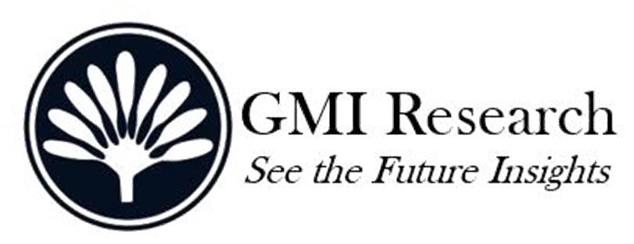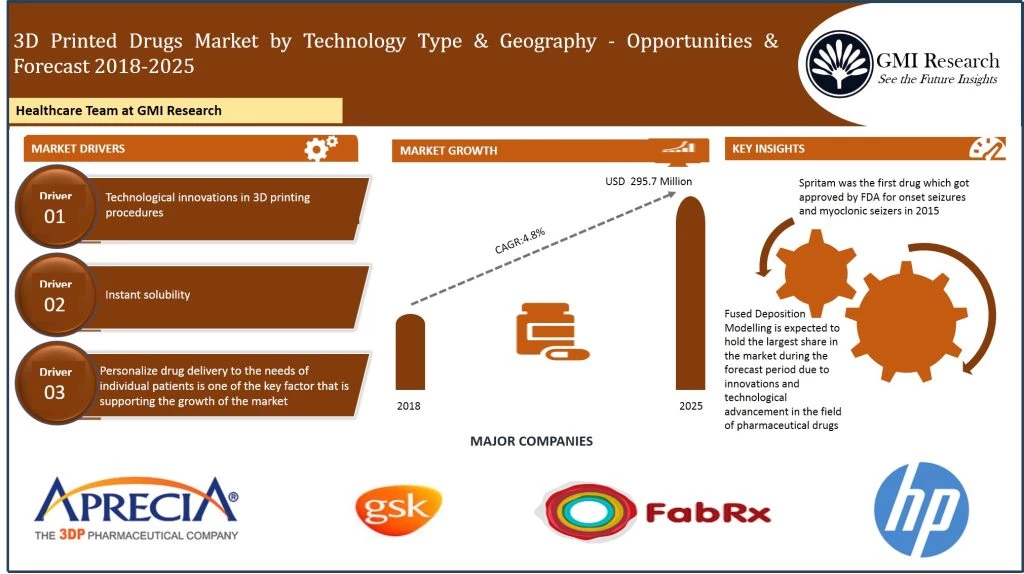Press Release
Inkjet Printing technique to proliferate in the global 3D Drugs market and is expected to witness a high growth during the forecast period (2018-2025) owing to technological advantage and rising awareness about the drug – GMI Research
The global 3D printed drugs market exhibited a value of USD 214.3 million in 2017 and is projected to reach USD 295.7 million by 2025, growing at a CAGR of 4.2% during 2018–2025. The key factors boosting the market growth are the technological innovations in 3D printing procedures, the instant solubility of the drug in the mouth, and a rising number of epilepsy patients.
Furthermore, increasing adoption of new generation 3D printing technology, growing incidence of epilepsy, rising technological advancement and spending on research and development by the top pharmaceutical companies like GlaxoSmithKline across have led to the burgeoning market growth of 3D printed drug market.
Fused deposition modeling segment is expected to dominate the global 3D printed drugs market during the forecast period. In 2017, more than half of the market share was held by the fused deposition modeling technique. However, the inkjet printing technique type is expected to witness the fastest growth rate in the coming years because of growing adoption among healthcare professionals and patients due to extreme advancement in technology.
Increasing research & development coupled with technological advancement in the pharmaceutical drug are likely to spur the growth of the global 3D printed drugs market in near future.
“To tackle the deadly diseases pharmaceutical companies along with the 3D printing technology players are investing a lot in research and development of the 3D printed drugs. For instance, recently HP partnered with the Centers for Disease Control (CDC) for developing 3D printed drugs for the US’s deadly disease “Superbugs”. Every year around 2.0 million people in the US get directly infected with these superbugs and about 23.0 thousand people die due to the improper medical treatment. It is foreseen that personalized drugs will propel the growth of the 3D printed drugs market by 2025 “
—-GMI Research
In 2017, North America held the largest share in the market on the back of increased adoption of technology, large volume epilepsy of patients and innovation in 3D drug technology and procedures. In addition, there has been a rise in the incidence of epilepsy disease. Europe has been amongst the growing regions for healthcare 3D printed drugs market and is predicted to grow at a moderate rate during the forecast period.
Key takeaways:
• In 2017, more than half of the market share was held by the fused deposition modeling technique.
• Apprecia Pharmaceuticals, GlaxoSmithKline and FabRx Ltd, and Hewlett Packard are the leading players holding approximately around one-third of the market share.
• The inkjet printer product type is anticipated to grow at the highest rate during the forecast period from 2018 to 2025.
• In 2017, North America held the largest share in the 3D printed drugs market.
Some of the key players operating in the global 3D printed drugs market include 3D Printer Drug Machine, Aprecia Pharmaceuticals, FabRx Ltd, GlaxoSmithKline Plc., Hewlett Packard Caribe, BV, National University of Singapore, The University of Nottingham, UCL School of Pharmacy, University College of London, University of Glasgow and others.
The global 3D printed drugs market has been segmented on the basis of technique type and key geographies. Based on technique type, the global 3D drugs market comprises of fused deposition modeling, inkjet printers, and others also including key geographical areas.
The research report on 3D drugs market provides an in-depth analysis of the global 3D printed drugs market, based on technique type and major geographies for the forecast period from 2018 to 2025. The report highlights the major market drivers propelling the growth as well as challenges faced by the market participants. The research report also provides market size and forecast for 3D printed drug market. The report also analyses the competitive landscape, major players and their strategies in 2018. The competitive landscape section of the report captures and highlights the recent developments in the market.
For more details, browse the Table of Contents: https://www.gmiresearch.com/report/global-3d-printed-drugs-market-by-technique-type/
Early buyers will get customization upto 25% on report
Contact Sarah Nash
Tel: +353 1 536 3035
U.S Office +1 860 881 2270
Europe Office +353 1 442 8820
Email: enquiry@gmiresearch.com

